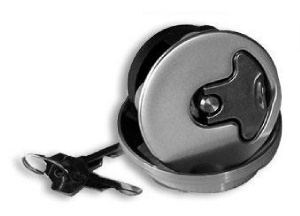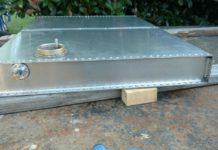The first Glasair kit was shipped over 25 years ago and now there are hundreds flying. In many cases these flying airplanes are introducing the second and third owners to the joys of flying the Glasair. For us here at NewGlasair this means often having to educate each new owner (and often their Mechanic) to the aircraft systems and subtleties. I hope to do some of this educating on this site.
A second item seen several times this last month is the call from the gung-ho new builder who has just got a Glasair I kit still in the box. Since the Glasair line has evolved much since the Glasair I, I like to give these builders hints and instructions from later kits, which will allow them to incorporate these later ideas in their airplanes.

To start off this first article, I would like to address the likely boring subject of Gas Caps. The Glasair kits over the years have been supplied with two different styles of Gas Caps. The Glasair I was typically supplied with the “Thermos Cap” style cap. This style simply was pushed down into the wing receptacle and the lever cap pushed down expanding the rubber seal body. This style sealed fine when properly adjusted but the rubber body had a tendency to swell and was difficult to fine tune the adjustment so the cap could easily be removed to refuel.
Beginning with the G-II the gas cap was redesigned so that the cap no longer used the rubber body to seal but instead used the flat rubber seal under the cap. This “new style” gas caps fit through a now machined slot receptacle and was turned against a stop pin before the latch was pushed down to seal the cap.
The reason for all this history is that because of the superior performance of the “new style” gas cap NewGlasair does not stock the “thermos style” gas cap. Opening and closing the gas caps occurs with every fillup and leads to equal opportunity for that gas cap to be incorrectly reinstalled. If the gas cap is not in tight it “will” leave the airplane on takeoff. What this means is that those Glasair I airplanes with this “thermos style” cap cannot call up NewGlasair and expect us to be able to overnight a new “thermos style” cap to Poduncville or even Oshkosh.
My first recommendation is for all Glasair flyers is to carry a spare gas cap. I also strongly recommend that all aircraft with the “thermos style” cap plan a retrofit to the “new style” caps before you lose a cap and I have to give you the bad news. Retrofit kits with instructions are available from NewGlasair. I have done this retrofit on the company G-I FT and can give some hints to those doing this retrofit.
If anyone has done this retrofit and now has left over “thermos style” caps, they can send them to me and I will keep them in my desk and send them (gratis) to builders who do find themselves away from home without a gas cap.
Now after saying that the Glasair was shipped with two possible different styles of gas caps, I have seen one other hybrid style of gas cap on one Glasair I which came to old Stoddard Hamilton Service Center. I suspect it was builder modification. For my education do any of the G-I builders out there have any knowledge of this mod? I do not remember seeing anything in old Newsletters regarding this mod.
This week is the Arlington Airshow and I hope to get out to the flightline and look at the Glasairs and speak with the builders. I always find it very interesting to look for the custom ideas and then get the scoop on how well the mod has worked in service. I hope to relay some of this in the next article.



